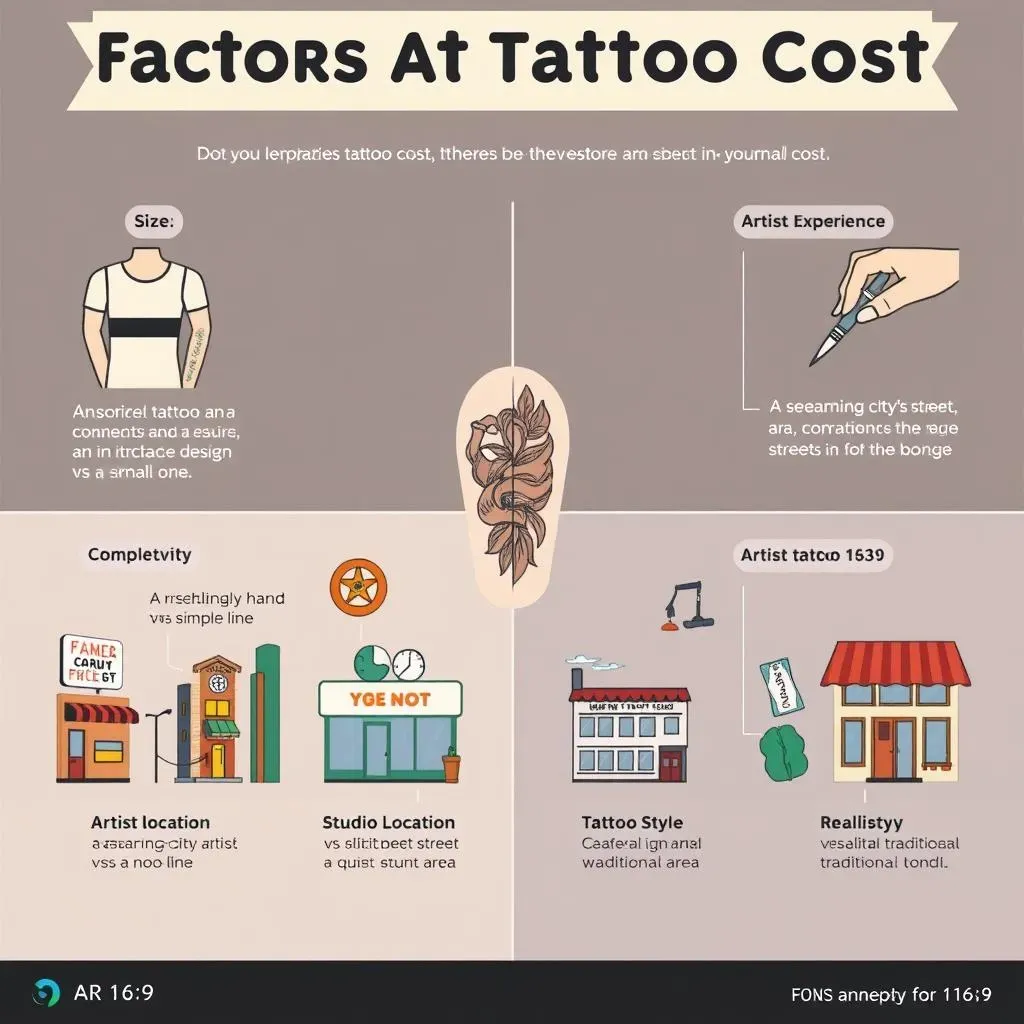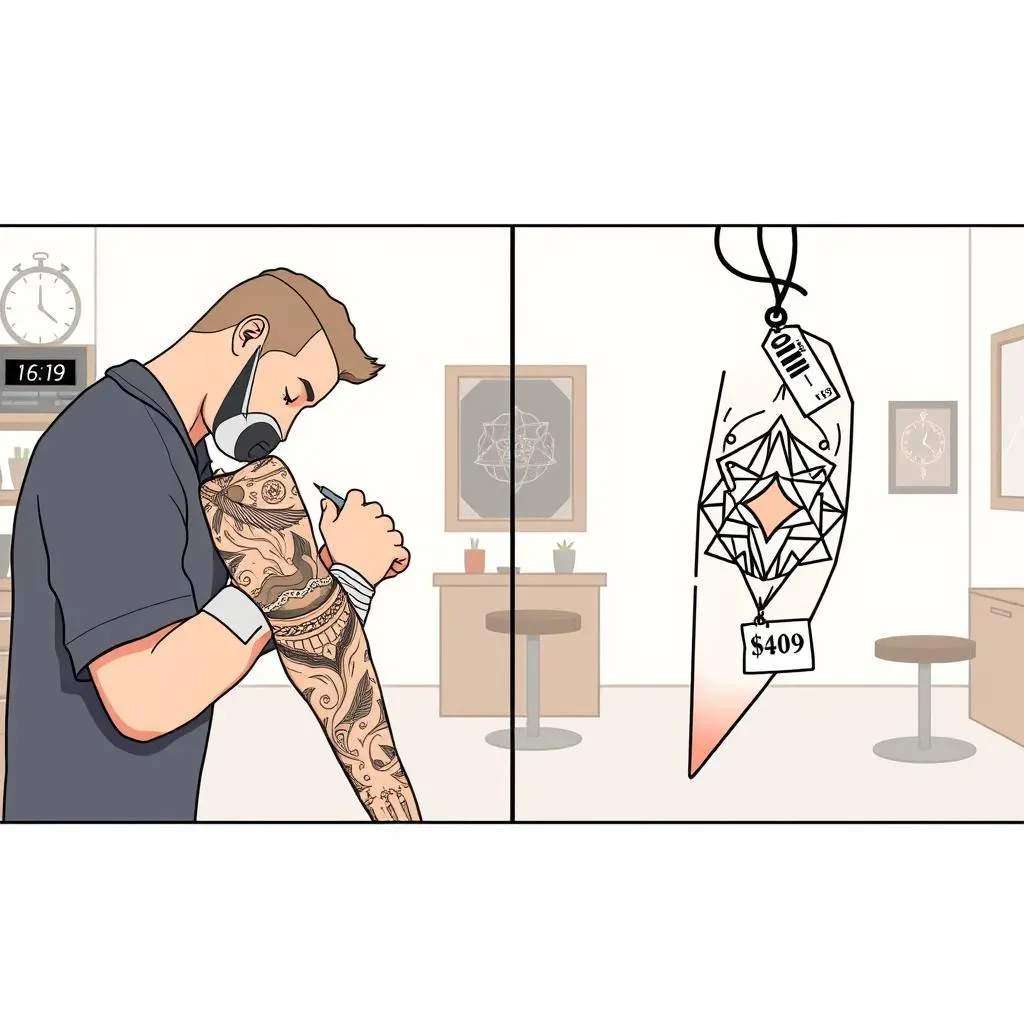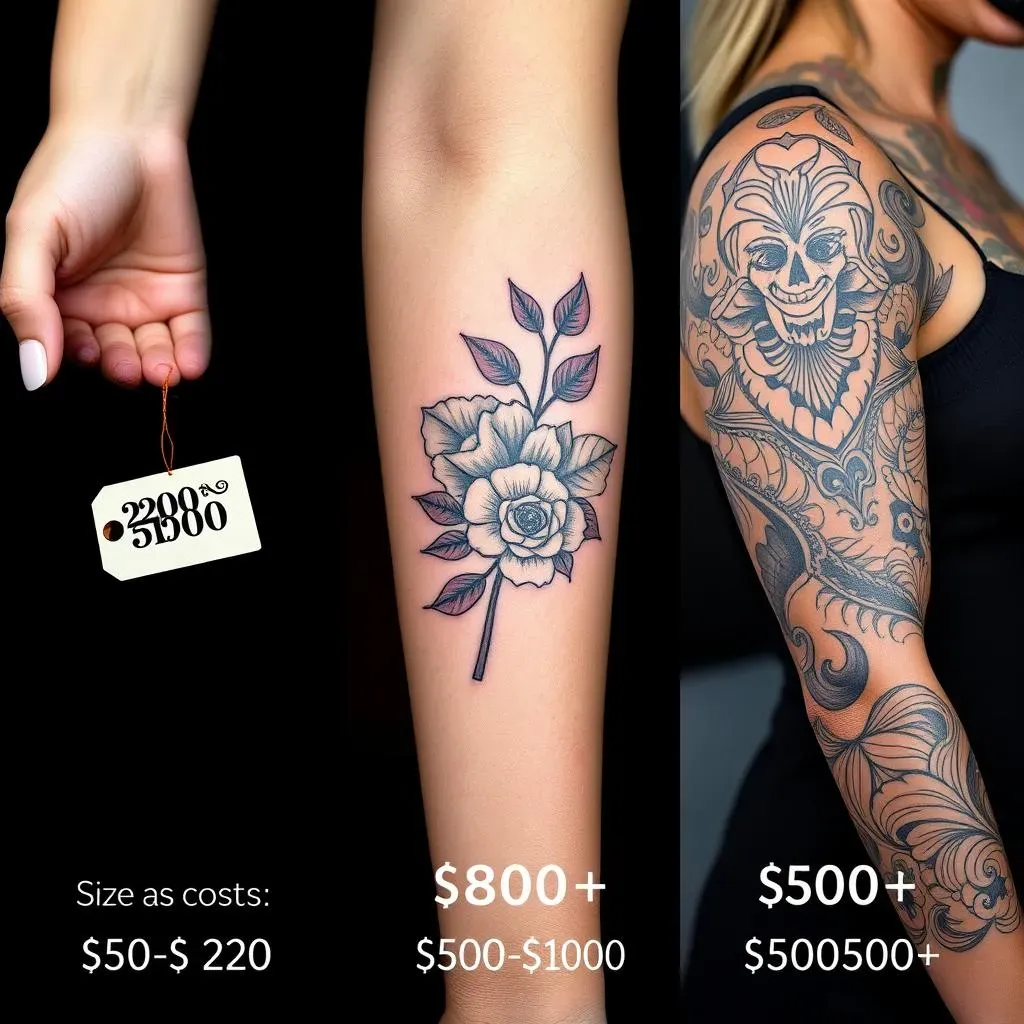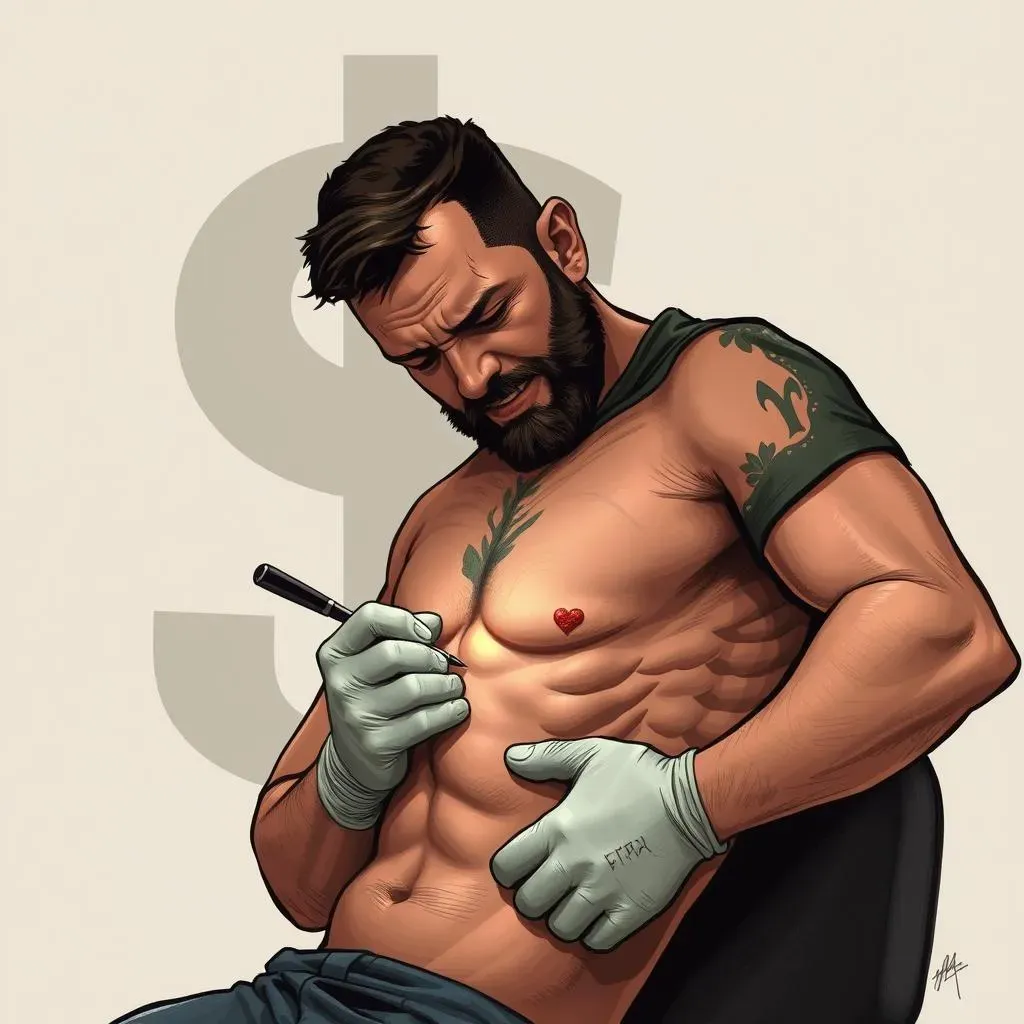Table of Contents
So, you're itching to get some ink? Awesome! But before you dive headfirst into the world of needles and vibrant colors, there's a crucial question to answer: how much do tattoo designs cost? Let's be real, tattoos are an investment, and understanding the pricing landscape is key to avoiding sticker shock and ensuring you get the art you're dreaming of without breaking the bank.
Factors Influencing How Much Tattoo Designs Cost
Factors Influencing How Much Tattoo Designs Cost
Alright, let's dive into what really makes the price of a tattoo tick. Several elements come into play, and understanding them is crucial. First off, the size of the tattoo design is a major factor. Naturally, a tiny wrist tattoo will cost significantly less than a full sleeve. Then there's the complexity of the design. Intricate details, shading, and color gradients all demand more time and skill from the artist, driving up the price. The artist's experience and reputation also matter. A highly sought-after artist with years of experience will typically charge more than someone just starting out. The location of the tattoo studio can also influence prices, with studios in major cities often having higher rates due to overhead costs. Finally, the style of the tattoo can affect the price. Some styles, like realism or watercolor, require more specialized skills and may command a premium.
Think of it like this: you're not just paying for the ink, you're paying for the artist's expertise, the studio's environment, and the assurance that you're getting a high-quality, lasting piece of art. It's an investment in yourself and your personal expression.
Factor | Impact on Cost |
|---|---|
Size | Larger = More Expensive |
Complexity | More Details = More Expensive |
Artist Experience | More Experience = Higher Rate |
Studio Location | Prime Location = Higher Overhead |
Tattoo Style | Specialized Styles = Premium |
Tattoo Pricing Structures: Hourly vs. Flat Rate
Tattoo Pricing Structures: Hourly vs. Flat Rate
Hourly Rates: The Time-Based Approach
so you've got a design in mind, now it's time to talk money. Many artists charge by the hour, and this is pretty straightforward. The artist tracks the time they spend actually tattooing you, and you pay for that time. Hourly rates can vary widely depending on the artist's experience, location, and the complexity of the design. Keep in mind that the clock starts when the needle hits your skin, so any prep time, like stenciling or setting up, might also be included in the hourly rate. It's crucial to ask the artist beforehand what their hourly rate is and what's included in that rate to avoid any surprises later on.
Hourly pricing is often used for larger, more complex pieces where the exact time required is difficult to estimate upfront. It allows for flexibility if the design evolves during the process or if unexpected challenges arise. For example, a full sleeve tattoo with intricate details and multiple color layers would likely be priced hourly, as the artist needs to account for the unpredictable nature of such a large and detailed project.
Flat Rates: The All-Inclusive Deal
On the other hand, some artists offer flat rates for certain designs. This means they'll give you a fixed price for the entire tattoo, regardless of how long it takes to complete. Flat rates are often used for smaller, simpler designs where the artist can accurately estimate the time and materials required. This can be a great option if you want budget certainty and don't want to worry about the clock ticking.
However, it's important to clarify what the flat rate includes. Does it cover touch-ups? What happens if you want to make changes to the design mid-session? Make sure you get all the details in writing before you commit to a flat rate. For instance, a small, simple geometric design might be offered at a flat rate, providing a clear and predictable cost for the client.
Pricing Structure | Pros | Cons |
|---|---|---|
Hourly Rate | Flexibility for complex designs, accounts for unforeseen challenges | Can be unpredictable, potential for cost overruns |
Flat Rate | Budget certainty, predictable cost | Less flexible, may not cover changes or touch-ups |
Average Tattoo Design Costs by Size and Complexity
Average Tattoo Design Costs by Size and Complexity
Tiny Tattoos: Minimal Ink, Minimal Investment
Let's start small, shall we? Tiny tattoos, like a simple symbol, a small word, or a minimalist design, are the most budget-friendly option. These can range from $50 to $200, often reflecting the studio's minimum charge. Even if the tattoo itself only takes a few minutes, studios usually have a minimum fee to cover setup, sterilization, and materials. If you're looking for a discreet and affordable way to express yourself, a tiny tattoo might be just the ticket. Think of it as a gateway drug to the wonderful world of ink!
These small tattoos are perfect for those wanting to test the waters or add subtle personal touches. For example, a small heart on your wrist, a semicolon behind your ear, or a tiny star on your finger are all popular choices. But don't underestimate their impact – even the smallest tattoos can carry significant meaning.
Medium-Sized Tattoos: The Sweet Spot
Moving up the scale, medium-sized tattoos offer more room for detail and creativity. These can range from $200 to $800, depending on the complexity, color, and the artist's rate. A palm-sized design with moderate detail, like a floral piece or a geometric pattern, would fall into this category. Medium-sized tattoos allow for more intricate shading and color work, making them a great choice for those who want a more visually striking piece without committing to a large-scale project.
When it comes to medium-sized tattoos, the possibilities are endless. You could opt for a realistic portrait of a beloved pet, a vibrant watercolor design, or a bold traditional tattoo. The key is to work closely with your artist to develop a design that fits your style and budget.
Tattoo Size | Average Cost | Examples |
|---|---|---|
Tiny | $50 - $200 | Small symbols, single words, minimalist designs |
Medium | $200 - $800 | Palm-sized designs, floral pieces, geometric patterns |
Large and Complex Tattoos: Committing to the Canvas
Now we're talking serious ink! Large and complex tattoos, such as full sleeves, back pieces, or intricate designs covering multiple body parts, can cost anywhere from $1,000 to $5,000 or even more. The price will depend heavily on the design's detail, the artist's rates, and the number of sessions required to complete the tattoo. These are major investments, both financially and in terms of time and commitment.
Large-scale tattoos are often collaborative projects between the artist and the client, requiring multiple sessions and careful planning. If you're considering a large tattoo, be prepared to invest significant time and money, and choose an artist who specializes in the style you're looking for. For example, a full back piece depicting a mythological scene could take dozens of hours and cost thousands of dollars, but the result can be a stunning work of art that you'll cherish for life.
Body Placement and Its Impact on Tattoo Design Costs
Body Placement and Its Impact on Tattoo Design Costs
Pain and Accessibility: The Price of Location
so you've got the design, you've got the budget, but have you thought about where you want that tattoo? Body placement plays a significant role in how much tattoo designs cost. Certain areas are notoriously more painful to tattoo than others. Think ribs, spine, feet, and hands – these spots often require more breaks and a higher pain tolerance, which can translate to longer sessions and, therefore, higher costs. Plus, some areas are just harder for the artist to access, requiring more contortions and adjustments, which also adds to the time.
Not only that, but some placements require a skilled artist who is experienced in tattooing that area. Areas where the skin stretches and moves a lot, like the stomach or inner bicep, are more challenging and require a steady hand. An experienced artist will know how to work with the contours of the body and ensure the tattoo looks good and heals properly. It's not just about the pain; it's about the artistry and expertise required for those tricky spots!
Size Distortion and Detail: Planning for the Canvas
Another factor to consider is how the body placement will affect the appearance of the tattoo over time. Areas that are prone to weight fluctuations or skin stretching, like the stomach or thighs, may cause the tattoo to distort or fade more quickly. This means you might need more frequent touch-ups, which will add to the overall cost. Also, the size and detail of the tattoo need to be carefully considered in relation to the body part. A small, intricate design might get lost on a large area like the back, while a large, bold design might overwhelm a smaller area like the wrist.
Ultimately, the best body placement for your tattoo depends on your personal preferences, pain tolerance, and budget. But it's important to have an open and honest conversation with your artist about the pros and cons of different locations before making a final decision. They can offer valuable insights based on their experience and help you choose a placement that will look great and last for years to come. Remember, it's a collaboration, and their expertise is invaluable!
Body Placement | Pain Level | Potential Cost Impact |
|---|---|---|
Ribs | High | Longer sessions, higher cost |
Spine | High | Longer sessions, higher cost |
Feet/Hands | High | Longer sessions, higher cost |
Stomach/Thighs | Medium | Potential for more touch-ups due to stretching |
Budgeting for Your Tattoo: Tips and Additional Costs
Budgeting for Your Tattoo: Tips and Additional Costs
Setting a Realistic Tattoo Budget
so you're ready to get inked, but budgeting for your tattoo is key! First, research average tattoo costs in your area. Prices can vary significantly from city to city and studio to studio. Online searches, tattoo forums, and consultations with local artists can give you a good baseline. Then, be honest with yourself about how much you can realistically afford to spend. Don't forget to factor in not just the cost of the tattoo itself, but also potential additional costs like aftercare products, tipping your artist, and any travel expenses. It's better to save up and get the tattoo you truly want than to settle for something cheaper that you'll regret later.
Think of your tattoo as an investment in yourself. Just like you wouldn't skimp on a good haircut or a quality pair of shoes, you shouldn't cut corners when it comes to something that will be on your body permanently. A well-planned tattoo budget ensures you get the art you desire without financial stress.
Hidden Costs and Extra Expenses
Now, let's talk about those sneaky additional costs that can creep up on you. Tipping your artist is customary, usually around 15-20% of the total cost. Also, you'll need to invest in proper aftercare products, such as antibacterial soap and a healing balm, to ensure your tattoo heals properly. And don't forget about potential touch-ups! Even with the best aftercare, tattoos can sometimes fade or require minor adjustments, especially in certain areas of the body. It's wise to set aside a small amount for these unforeseen expenses. Preparation will keep you stress free!
Also, consider the opportunity cost. Will getting this tattoo mean sacrificing other things you want or need? A little bit of financial planning can prevent buyer's remorse and ensure your tattoo journey is a positive one.
Cost Category | Estimated Amount |
|---|---|
Tattoo Cost | Varies based on size, complexity, and artist |
Artist Tip | 15-20% of tattoo cost |
Aftercare Products | $20 - $50 |
Potential Touch-ups | $50 - $200 (if needed) |
Wrapping Up: Making Informed Ink Decisions
Ultimately, understanding how much tattoo designs cost empowers you to make informed decisions. By considering the factors discussed, researching artists, and planning your budget, you can confidently embark on your tattoo journey. Remember, a tattoo is a lasting piece of art, so prioritize quality and artistry over the cheapest price. With a little knowledge and planning, you can achieve your dream tattoo without emptying your wallet and enjoy your body art for years to come.